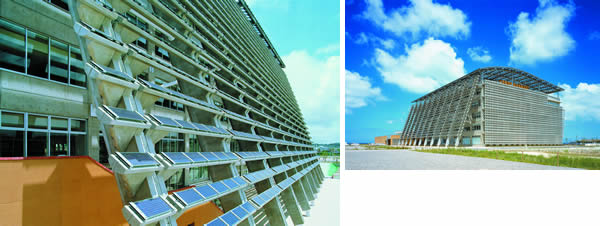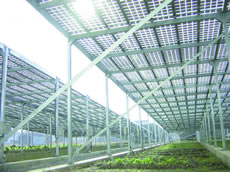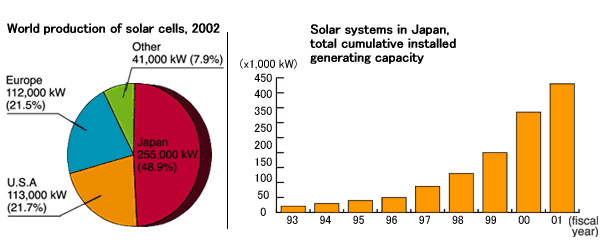|
Special Feature*
Generating Your Own Electricity

Right: New city office building in Itoman, Okinawa Prefecture.
Left: On the south-facing wall, solar panels have been installed from the roof almost to ground level. They generate electricity, and also provide shade as awnings.
|
Japan is also the world leader in solar generating capacity. When a survey was done in fiscal 2001, the generating capacity in Japan was approximately 450,000 kW. That is about twice the capacity in Europe, and three times that in the United States. Interestingly, about 90% of the solar power generated in Japan comes from panels on ordinary homes. It is true that one reason for this is that people are now more concerned about global pollution, but the most important reason is that the cost of solar panels is falling.
In 1992, it cost almost 4 million yen to install a solar electric system capable of generating 1 kW of power. Today, the price tag is about 800,000 yen, one-fifth what it was a decade ago. This is not so much because the solar panels themselves cost less but because the DC/AC converters and other peripheral equipment now have a more practical design.
The average family of four in Japan consumes around 3 or 4 kW of electricity per hour. They can generate this amount on their roof if the part oriented toward the sun measures around 20 to 30 square meters in area. A large-scale solar electric utility needs a wide expanse of ground, so it makes sense to install panels on the roofs of many homes. So it could be that the best way to obtain electric power from the sun is for individual homes to generate it themselves, for their own use.

If your solar panels let sunlight strike the ground, as they do here, you can grow vegetables under them and generate electricity at the same time.
|
The main advantages of solar power are: the panels can be set up on roofs and other places not ordinarily used; there are no moving parts, so electric generation is quiet; the system has a long lifespan; and no maintenance is needed.
There is one disadvantage, of course: you cannot generate electricity at night or when the weather is bad. But at those times you can get around this problem by buying power from the local electric utility, or by using the surplus electric power you stored in batteries.
The Japanese government has set a goal of about 4,820,000 kW of solar electricity generated in the country by 2010, more than 10 times the present level. This would save about 1,180,000 kiloliters of crude oil—and that would mean less carbon dioxide emissions from burning the oil. 
Charting solar power

Source: New Energy and Industrial Technology Development Organization (NEDO)
|
|